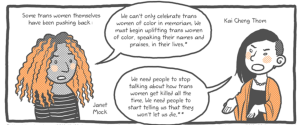To derail and maneuver away from discussions of race and racism – especially the topic of White privilege –one method that White people often wield is accusations of divisiveness.
“You are being divisive!” many of us have been told when raising issues of race, including, but not limited to, the racism of police brutality, Hollywood’s Whitewashing, daily microaggressions, and implicit biases.
Case in point: In the wake of yet another grand jury non-indictment, this time for the “police” officer who killed twelve-year-old Tamir Rice, musician Kimya Dawson posted the following tweet on her Facebook page:

“This is a pointless point that get [sic] everybody nowhere. Stop promoting division and start promoting understanding and coming together for all,” retorted one White man.
And if they don’t explicitly use a version of the word division, they still imply it.
“…life is hard for the human race. Pull up your knickers and fight back with love,” posted another White man.
Claims of divisiveness are closely connected to colorblindness, which too attempts to take racial identity off the table. Racial identity is a topic that makes many White people – who, as the dominant racial group, have the privilege to be unaware of their race – uncomfortable. And too often, White people’s comfort trumps all else.
These strategies of derailment border on satire, as racists have been using race to literally divide people for centuries, including, but not limited to, slavery, Indian removal, Jim Crow, Japanese American incarceration, and anti-miscegenation laws.
Now, as we attempt to fix a system built on division, “divisive” is used, almost like a slur, to stop these attempts. It makes little sense.
Nevertheless, such claims have even been used to shut down formal studies of race and racial identity. Former Arizona Superintendent of Public Instruction Tom Horne, a White man, distorted Tucson Unified’s Mexican American Studies (MAS) program by characterizing it as “dividing students up by ethnicity and treating them separately by ethnicity.” Despite MAS’s proven track record of dramatically reducing racial disparities, Horne successfully ended the program amid powerful student protests.
Not long after, one parent in Wisconsin, presumably White, pulled the plug on a high school course called “American Diversity” using similar rhetoric: “They’re dividing students.” The course included multiple lessons on White privilege.
One White family tried the same with the course I teach in Seattle, claiming open discussions race and racism created, among other things, “social divisions.” This one White family, with the help of an unprepared district, temporarily shut down the course until an arbitrator ruled otherwise.
Hopefully, we can all get behind James Baldwin’s words: “You cannot fix what you cannot face.” That is, to challenge racism, we need to face race, regardless of conversation-stopping cries of division.
But since those who oppose racial dialogue clearly appreciate satire, here’s some more right back at them.
You don’t like division? Then you picked the wrong country to call home. The following cultural norms – all irrefutably accepted as integral to mainstream to American culture – are inherently “divisive.”
1. Private Property
Of course, I would never say such a thing, as that would be like criticizing Star Wars; luckily, John Steinbeck already did through his masterpiece, Grapes of Wrath: “For the quality of owning freezes you forever into ‘I,’ and cuts you off forever from the ‘we.’”
Steinbeck was onto something.
I’ve often tried to meet with billionaire Bill Gates at his pad for tea in one of his six kitchens, but his formidable security gate even won’t let me reach his front door. In contrast, I practically run through the tented bedrooms of the homeless in a number of Seattle parks.
The more private property you own, it seems, the greater the division.
Private property is so sacred that Woody Guthrie’s American anthem, “This Land Is Your Land,” was stripped of a verse in which the narrator disregards a “No Trespassing” sign because its empty backside was what was made for you and me.
2. Cars
During our daily commute (on streets divided into lanes), we could be socializing, debating public policy, and even community organizing via efficient public transit. Instead, too many of us are stuck divided into our individual, near-vacant vehicles, often in overly congested roads.
Our reliance on cars is no accident.
According to Eric Schlosser, author of Fast Food Nation, General Motors sabotaged its railway competition in the 1920s by secretly buying up trolley systems across the country – and subsequently dismantling them. (Luckily, these actions were done without any public input, as such discourse could have been divisive.)
And a century later, we continue to prioritize sitting in these pavement-hogging pollution factories – even in the face of potentially irreversible climate change that could devastate poor countries, not to mention end humanity – over doing what we evolved to do: actually moving our bodies.
3. Airlines
Sure, airlines separate people from the ground, but what’s more insidiously divisive is first class, which gives only a select few preferential treatment: early seating, roomy seats, complete meals (including, I’ve heard, alcohol), and increased bathroom access.
Some of the most Mother-Teresa-like people I know have yet to receive such treatment by airlines.
Instead, this hierarchal system has forced them to the back of the plane, euphemistically called “coach,” into cramped seats with hundreds who must share limited bathrooms and resort to mixed nuts, if hungry. Even union organizers compliantly endure such intolerable conditions.
4. Bathrooms
I hadn’t put much thought into the complexities of bathrooms for most of my cisgender life until I started learning more about transgender, genderqueer, and non-binary experiences.
While the gender binary always seemed problematic – not just because it dichotomizes genders, but also because it devalues pretty much everything in the “female” column – I had never considered the dilemma that a full bladder can create for someone who doesn’t fit into such limited options.
And Americans embrace this divisive dichotomy so much that they are willing to fight like hell for it.
In Houston, the reason many residents voted down Proposition 1, which would have created a “broad swath of nondiscrimination protections,” ultimately boiled down to bathrooms. Despite the proposition’s vocal support from celebrities, the opponents’ campaign of fear that “vilified transgender people as sexual predators” ultimately prevailed.
Houston will have to wait for the unifying reimagining of traditional bathroom signage.

5. Private Education
In Brooklyn Quarterly’s “Generations Left Behind,” Sarah Kendzior explains the deep and lasting divisiveness created when educational opportunities are tied to bank accounts:
In America, education has become a prize for people who have already won. Those with money, connections, and access to technology travel a path that starts with private preschools, continues through SAT tutors and exorbitant enrichment activities, and culminates in college that costs more than the national median income.
Washington University in St. Louis, for example, charges $63,373 in tuition, room and board, with tuition alone costing $47,300… By contrast, most American families struggle with a lack of early childcare options, subpar and underfunded public schools, after school jobs for teenagers meant to pay household bills, and massive university debt. There are two tiers and the divide begins not with the child’s ability, but with his or her parents’ income.
“Two tiers?” “Divide?” Fortunately, we can turn to public education for a level playing field free of divisions.
6. Public Education
Oh shit! Public education makes the list as well. And though our public education system has the potential to level the playing field, it too often replicates the status quo of class divisions. If you are poor, you often start deep in a neglected ditch of that “level” playing field.

Last year, poor students in Seattle schools received as few as fifteen minutes of recess – that is until educators in Seattle struck last fall and won thirty minutes of guaranteed recess time. But educators didn’t win free transportation to school for poor students living up to two miles from school. The students themselves fought for that win.
In contrast, rich students, with ample access to playtime and transportation, fill the advanced classes that serve as bridges to higher education. One advanced “self-contained” program, longtime called the Accelerated Progress Program (APP), has disproportionately served rich students for years.
In the wealthier North End schools of Seattle, APP students make up over 11% of the population, even though APP is supposed to be limited to the top 5% nationally. I’m not sure we North End Seattleites are that smart. (Note that Seattle is hardly the only district that neglects the poor and gifted.)
I taught an APP course for a year in a school that was separated into three tracks: APP, Spectrum (advanced but, according to test scores, not as advanced as APP), and general education. I overheard many APP students refer to students in general education as “gen-edders.” One student even chastised herself after making an error by calling it a “gen-ed” mistake.
Such segregation might explain this sticker I found outside an “integrated” school known for its race- and class-based tracking:

7. College Majors
After many students finally make it into college, settle into college life, and start building a new community for themselves, they must a pick a major – a divisive rite of passage that segregates young people by something as arbitrary as one’s interest.
Imagine if we separated children based on something equally arbitrary like, say, a particular color. Unthinkable.

8. The Greek System
While the Greek system bonds people within a given chapter, even inspiring group chants and themed parties, not all make the cut into the mansion-like houses on Greek Row of the University of Washington (UW).
One inside source at UW reports that, at parties, fraternities regularly “regulate” which Greek affiliations enter for men, but keep their doors open to women regardless of affiliation.
Sounds divisive (as does what I read about hazing, especially if your humiliation doesn’t earn you entry).
9. The Managerial Class
While the promotion to manager often comes with a modest pay boost, from a labor perspective, the managerial class is labor-dividing.
It creates an artificial group between the owning and the working class, undermining the unity of the employees. In fact, one primary function of the managerial class is keeping the working class in line, further protecting the owning class from possible labor unrest and profit redistribution.
Don’t like division? Might need to turn down that next promotion.
10. Democrats and Republicans
The two dominant parties are so divisive that they limit third-party competition and stick an entire aisle between them. Party segregation is so entrenched that crossing the aisle makes news headlines.
And party members have a vested interest in not working together. If they collaborated well, a party would have no one to blame during the next election.
11. The Super Bowl
The New Year. It should be time we all come together as one community, working for a year better than the last one. Instead, Americans are sharply at odds based on which football team they support.
Come to think of it, most sports seem to be similarly divisive. Even the low-spectator sport of track. I periodically run with a track club and, for every single workout, the coach separates us into pace groups. Not coincidentally, the fastest pace group never says hello to me (though, to note, I am socially awkward).
This year is an Olympic year. Over the summer, millions of Americans will rally behind American athletes. Yet, with the exception of a few highly marketed stars, most of these athletes will be no more familiar than their competitors from the other 205 countries, which reminds me of another divisive issue:
12. Patriotism
In his book Passionate Declarations, historian Howard Zinn quotes feminist and anarchist Emma Goldman about the divisiveness of patriotism:
Conceit, arrogance, and egotism are the essentials of patriotism…Patriotism assumes that our globe is divided into little spots, each one surrounded by an iron gate. Those who had the fortune of being born on some particular spot consider themselves better, nobler, grander, more intelligent than the living beings inhabiting any other spot. It is, therefore, the duty of everyone living on that chosen spot to fight, kill, and die in the attempt to impose his superiority upon all others.
I might add “armed conflict” to the list, except there were those 21 years – since 1776 – during which the United States was not putting its military to work. I’m not sure that 93% of the time qualifies as a “cultural norm.”
13. Other Borders
In addition to the socially constructed national borders, we also carve the land into states, congressional districts, legislative districts, counties, county council districts, cities, city council districts, school districts, and school board districts – and, in Washington at least, they rarely overlap!
These divisive borders not only create unhappy civics students, but also unnecessary rivalries.
For example, I often mock my family in Portland, Oregon for choosing a city split by a mucky river over choosing Seattle, an urban paradise nestled among an oasis of vast bodies of water and majestic mountain ranges.
***
While many of these examples are satirical, they truly are undeniably “divisive.” Yet few would label them as such, let alone attach to them negative connotations. Perhaps because so many of us cling to the myth of meritocracy, we are particularly slow to label, not to mention challenge, class divisions.
But we must remember – and the work of Shakti Butler will help us remember – that the system that has created class divisions, a norm we accept, is the same system that has fueled racial inequality, a topic we too often avoid.

It makes little sense to accept one offspring as a norm and the other as a taboo.
If you are one who has avoided or even defensively shut down discussions of race, it’s never too late to make a change. In fact, when it comes to racial dialogue, defensive reactions are arguably a rite for passage for White anti-racists – an early step in the long journey of challenging racism.
We’ve all been there. Just don’t stay there.
And if you have made sincere attempts at discussing race and they continue to implode, try out the following guidelines developed by racial-dialogue experts, Özlem Sensoy and Robin DiAngelo.
It’s hard work, but so is winning a Super Bowl.
[do_widget id=’text-101′]
Jon Greenberg is a Contributing Writer for Everyday Feminism. He is an award-winning public high school teacher in Seattle who has gained broader recognition for standing up for racial dialogue in the classroom — with widespread support from community — while a school district attempted to stifle it. To learn more about Jon Greenberg and the Race Curriculum Controversy, visit his website citizenshipandsocialjustice.com. You can also follow him onFacebook, Tumblr, and Twitter @citizenshipsj.
Search our 3000+ articles!
Read our articles about:
Our online racial justice training
Used by hundreds of universities, non-profits, and businesses.
Click to learn more





















